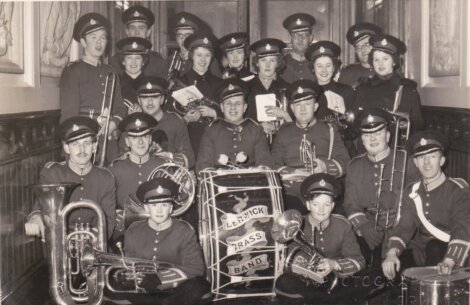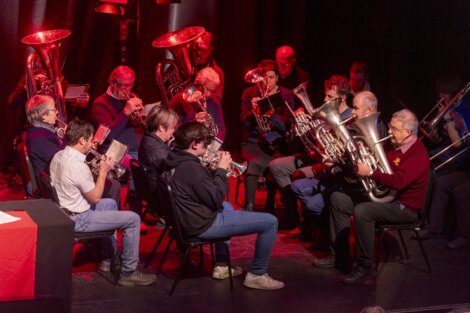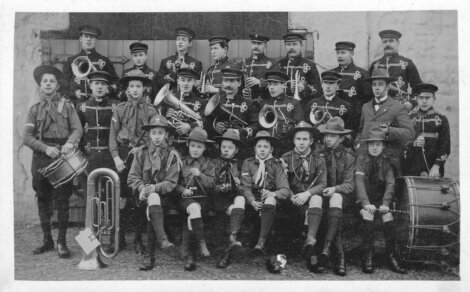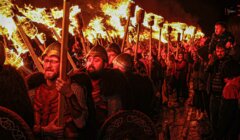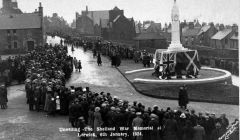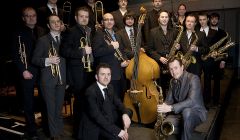Features / Lerwick Brass Band: a long history with Up Helly Aa
“IT IS very possible that without Up Helly Aa there would be no Lerwick Brass Band today.”
Dougie Johnstone has played the drums with the group for nearly 60 years – so it is fair to say he knows the drill when it comes to performing at Up Helly Aa, and the event’s importance to the history of the brass band.
On the last Tuesday in January the limelight falls on the guizer jarl and his squad, but the brass band has, for more than a century, helped to provide important musical accompaniment – in all weathers.
Unsung heroes, perhaps; along with the squad’s own musicians as well as the pipe band, the music adds a vital spark to the day’s proceedings and gives a melodic backing to the bellows of the jarl squad.
Of course, it is not just the Lerwick event the brass band perform at, with the Scalloway, Nesting and Girlsta, Northmavine, Bressay, South Mainland and Delting fire festivals also on the agenda in a busy January to mid-March period.
The brass band’s association with Up Helly Aa is deep-rooted, having first played the Lerwick event in 1888 – even before a longship appeared the following year.
There were a few bumps in the road early on, including struggles with finances – the group’s original bandmaster charged £10 a year for his services, for instance, making money tight.
But after a number of years out of Up Helly Aa the band was revived for the 1914 festival by the previous year’s jarl Mackie Scott, great-great-grand-uncle of 2020 jarl Liam Summers.
Up Helly Aa returned after the Second World War in 1949 but the brass band had not reconvened yet, “so the committee set to work”, Johnstone – who is the brass band secretary – said.
“The story goes that the Up Helly Aa committee members visited the former members of the band and plied them with whisky until they agreed to reform and take part in the procession,” he added.
Become a member of Shetland News
“A band of about 15 players was mustered. Possibly a myth, but the perfect origin story for the ritual ‘visitations’ by the jarl and his squad and by the committee and ex-jarls which have taken place in the bandroom early in January for as long as we can remember.
“This year, for the second time, the party was held in Islesburgh with the committee, jarl’s squad and ex-jarls all attending while the band provided the music.”
Johnstone said therefore on two occasions, 1914 and 1949, the festival was effectively responsible for the revival of Lerwick Brass Band – and without Up Helly Aa the group may not exist.
Explaining what the Up Helly Aa day is like for the band, Johnstone said the group meets at the Legion in the morning and plays for the parade with the squad and galley to Alexandra Wharf, as well as a walk along Commercial Street.
“We are then free until the junior procession at tea-time followed about an hour later by the main event,” he said.
At the fiery procession the band plays a ranks march – a tune chosen by the guizer jarl – when the squad marches up the ranks before torches are lit.
This particular tradition began in 1959, and the ranks march tune remains a closely held secret until the day itself.
The song is the key focus for pre-festival practices, given that most members have the usual tunes – such as the Up Helly Aa Song and the Galley Song – no doubt ingrained in their minds.
Johnstone said one moment at the procession which always sticks out in the mind – “right from the very first time when I was 16 playing cymbals” – is when the band are at the crossroads outside George Robertson’s.
“There’s two lots of guizers on either side of us, and then the band is four people wide,” he said. “Everything just seems to close in on you – it’s difficult to describe, it’s the feeling of the torches coming in on you.”
The band then come down Lower Hillhead and end up at the scaffold bandstand within the corner of the playpark burning site, where they perform for the rest of the procession.
That in itself comes with some hazards – particularly in certain winds.
“The bandstand is fine, depending on the direction of the wind,” Johnstone said.
“If the wind is coming from the north then it blows the smoke from the torches right in our faces, and for those in the band having to read music, their eyes are streaming with the effect of the smoke.
“That bit actually can be an ordeal if the wind is in the wrong direction, but if it’s from a southerly direction, there’s no problem at all.”
The regularly inclement January weather has not proved too much of a problem for the brass band and their instruments over the years, as the rain can be wiped off.
However, the wind – again – has had its moments in the past. “I remember one year in the morning parade and we came around the corner at the bus station and hit a force eight gale straight into our faces,” Johnstone recalled.
“The [sheet] music just scattered all over the road – the band just stopped dead, and we had to gather up the music.”
There are three main tunes in the band’s Up Helly Aa repertoire – the Up Helly Aa Song, Norseman’s Home and the Galley Song.
The words to the Up Helly Aa Song were penned by local poet JJ Haldane Burgess more than a century ago, but the song did not become popular until the tune known today was written by Thomas Manson in 1921.
Meanwhile the first recorded use of the Norseman’s Home was at the beginning of the 1896 procession.
The lyrics to the Galley Song were created by Shetland author and poet John Nicolson, and the tune is traditional Norwegian. It was first used in 1935 and today is sung before the throwing of the torches, as well as during the procession.
However, in the early days Auld Lang Syne was sung towards the end.
“The arrangements of the Up Helly Aa music we play today were written for us by professional band arranger Patrick Rivers for the 1972 festival,” Johnstone said. “The arrangements used before then were by Joe Linklater, bandmaster in the early 1950s.”
A record was made of the tunes for the 1981 festival by the brass band and the senior teachers’ squad. It is still available to buy today, on CD too, while it is also on digital streaming service Spotify.
Meanwhile a fourth unofficial tune is Blaze Away, written by an American composer in the early 1900s, which has become a fixture as the final song after the Norseman’s Home.
There are also some other traditions for the brass band; the group plays the previous year’s ranks march at the opening of the following year’s mass meeting, of instance.
Aged 74, Johnstone said he is the oldest member of the brass band still out marching.
There are currently 27 players on the list, two of which are still at school.
With ten women in the group, Johnstone reckons it is the “largest number of ladies we’ve ever had”.
“Three played briefly towards the end of World War One but it was the mid 1950s before six joined when the band was being reformed under Bandmaster Bobby Burgoyne,” he explained.
“At that point there was an interesting debate with the Up Helly Aa committee who said ‘of course the ladies won’t be allowed to march in the procession’.
“Bandmaster Burgoyne stood his ground: ‘No ladies, no band!’ The committee gave in, and the first ladies took part in the procession in 1956.
“Until last year, of course, being a member of the brass or pipe bands was the only way for a lady to join the procession.”
Become a member of Shetland News
Shetland News is asking its many readers to consider paying for membership to get additional features and services: -
- Remove non-local ads;
- Bookmark posts to read later;
- Exclusive curated weekly newsletter;
- Hide membership messages;
- Comments open for discussion.
If you appreciate what we do and feel strongly about impartial local journalism, then please become a member of Shetland News by either making a single payment, or setting up a monthly, quarterly or yearly subscription.






